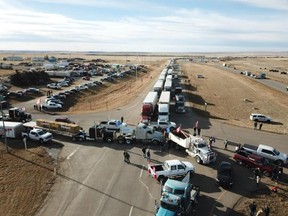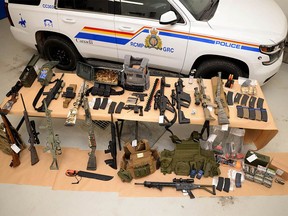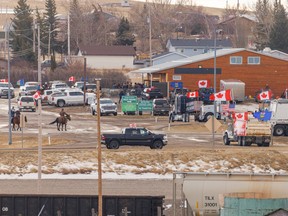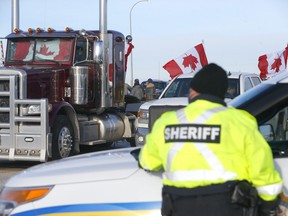Guns, doomsday culture, anti-government messages, the police response, the Emergencies Act — how will history view Coutts?
Article content
There will be a place in Canada’s history books for the divisive and dramatic blockade at Coutts, a busy border crossing between Alberta and Montana that saw a clamorous protest against COVID-19 health measures in 2022.
Although it stretched just 18 days, its repercussions continue in Canada’s courts, politics, national security and policing.
Just how future historians might view the Coutts protest — the people, the weapons, the doomsday last-stand culture, the camaraderie, the networking, the anti-government rhetoric, the frailty of the economy and infrastructure, the robust police response, and the outsized role it had for the invocation of the Emergencies Act — is anyone’s guess.
Advertisement 2
Article content
Through the ruckus, fear and hope from the national protests sparked by the Freedom Convoy during the stressful days of the pandemic, Coutts was largely lost in the noise of the more visible protest occupation in Ottawa, which sucked up most of the attention.
But it is Coutts, and what happened there, that might — just might — end up having the deepest impact.
Coutts is where the most dangerous known criminal activity was uncovered, where the most serious criminal charges were laid, where a cache of guns and insignia of an extremist network stoked fear, and where the private voices of its hardcore protesters and the sneaky methods of the RCMP to quell them are both revealed.
Information usually kept secret — on both sides — is available courtesy of a remarkable criminal trial that, while it has delivered verdicts, is still proceeding in Alberta’s superior court.
The trial featured testimony from anonymous undercover police officers, all women, who infiltrated the protest; apocalyptic text messages shared by hardcore protesters; allegations of government duplicity and political infringement in the justice system; and a jarring police interrogation of a protester accused of a plot to kill Mounties.
Advertisement 3
Article content
THE PROTEST
On Jan. 29, 2022, the day after the first Freedom Convoy protesters started parking trucks in Ottawa, another convoy of about a thousand vehicles rolled out of Lethbridge for the 106-kilometre drive southeast on Highway 4 to the Canada-U.S. border.
It created a magnificent traffic jam as it rolled into Coutts, a 224-person village just north of the Montana border. That international point of entry is a key trade route and the busiest border crossing in Alberta.
The rally was called to protest COVID-19 vaccine mandates and other public health measures and in support of the larger convoy encircling Parliament in Ottawa.
Most vehicles left Coutts by Jan. 31, but about 175 vehicles stuck around, sporadically blocking the border crossing in the snow.

At a news conference on Feb. 8, Jason Kenney, Alberta’s premier, announced an easing of COVID restrictions in a “careful and prudent” three-stage plan. His words didn’t dissipate protester resolve at Coutts, it seemed to harden it, with activists complaining Kenney was too slow and too soft.
A full border blockage was re-established at Coutts.
Article content
Advertisement 4
Article content
The protest tone shifted, the mayor of Coutts, Jim Willett, later told an inquiry: fewer families and children, more confrontation.
The blockade remained until Feb. 14, Valentine’s Day, when Prime Minister Justin Trudeau invoked the Emergencies Act, giving the federal government extraordinary powers to deal with what was deemed a public order emergency. The RCMP raided several facilities around Coutts that day, made some arrests and demonstrators mostly left.
From outside, it looked like the Emergencies Act did its job, helping oust the blockade and reopen the Coutts border crossing.
The public didn’t know it at the time, but the RCMP had already secretly infiltrated the Coutts protest with at least three undercover officers, and a turning point in handling the Coutts site had already been decided, back on Feb. 9, when the undercover officers heard of a stockpile of guns.
Emergency wiretaps were placed on the phones of suspects and search warrants were issued for three Coutts raids on Feb. 13, the day before the act was invoked.
The political story of the extraordinary use of the act and how it impacted the protest in the nation’s capital grabbed the most attention and the biggest headlines, but it was at Coutts that the most serious alleged criminal activity and intricate police activity was unfolding.
Advertisement 5
Article content
The RCMP announced the next day that officers seized 13 long guns, two handguns, two sets of body armour, a machete, a large quantity of ammunition, and high-capacity magazines around Coutts, and arrested a dozen people. In Lethbridge provincial court, prosecutors revealed that four of those arrested faced charges of conspiracy to commit murder.
Police announced that four Alberta men were charged with conspiracy to commit murder, along with gun charges and mischief: Chris Carbert, 44, Anthony Olienick, 39, Chris Lysak, 48, and Jerry Morin, 40.
A photograph released by the RCMP showed seized guns, ammo, other weapons, and tactical vests. One vest is decorated with a logo for Diagolon, a network described in the public inquiry report on the Emergencies Act as “a militia-like extremist organization.”

For convoy opponents, it confirmed their fear about the convoy movement — a hidden agenda, planned violence and extremists hiding behind the protests.
It came as a blow to other protesters as well. Marco Van Huigenbos, a Coutts protest organizer, told reporters: “The development with weapons and the personal armour was not associated with us, and to keep that distance we decided to leave peacefully.”
Advertisement 6
Article content
Soon after, Marco Mendicino, the federal public safety minister at the time, said the Emergencies Act was partly in response to the threat posed at Coutts.
“It could have been deadly for citizens, protesters and officers. We need to be clear-eyed about the seriousness of these incidents and, indeed, several of the individuals at Coutts have strong ties to a far-right extreme organization with leaders who are in Ottawa,” Mendicino said.
On the morning of Feb. 15, 2022, the border at Coutts reopened.

THE TRIAL
By the time a trial against those accused of the guns and murder plot at the border blockade was set, the Coutts Four had become the Coutts Two: This February, Lysak pleaded guilty to a reduced charge of possession of a weapon in an unauthorized place, and Morin pleaded guilty to conspiracy to traffic firearms. In the plea deals, the more serious charges of a plot to kill Mounties were withdrawn against the pair.
An agreed statement of facts said Lysak brought his rifle and bag of ammunition to the protest “so he could hunt coyotes if he found himself idle and bored.” He was staying in a trailer in Coutts. A few days before the police raids, he emptied his ammunition bag to use it for laundry and discovered his handgun was inside. He placed the handgun under a pillow in the trailer, where police later found it, loaded with a round in the chamber, the statement says.
Advertisement 7
Article content
For Morin, an agreed statement of facts says he was asked to bring his “guitar and amplifier” to the protest area, which was code for guns and ammunition. He agreed to, the document says.
They were both sentenced to time already served in custory while they waited for trial. When the enhanced credit for pre-trial custody was calculated in, it amounted to about a three-year sentence.
A jury was finally mustered for the trial of the remaining two in June.
A pool of about 100 potential jurors was whittled down to five men and nine women for the jury, including two backups. One potential juror was excused for wearing a T-shirt to court with the faces of the two accused on the front and waving to them in the prisoner’s box. Another was rejected because his brother was a cop; a third whose sister’s boyfriend was a cellmate of one of the accused.
The public trial began on June 5.
Testimony revealed an apocalyptic mentality among some at Coutts, seen in the words of protesters themselves, including from the accused men. A police expert testified that investigators retrieved about 100 gigabytes of data from phones seized during arrests and raids.
Advertisement 8
Article content
If we lose here, I will likely die in war
text message on phone seized durring Coutts’ raids
Vivid text messages were seen by the jury.
Carbert spent time trying to convince his mother.
“Mom I won’t be home until laws are passed and the government is toppled,” he told her. “I thought maybe you would go home for a couple days,” she replied. He responded: “I don’t think you truly understand what this is for and about. If we lose here, I will likely die in war.”
Olienick made arrangements for some important things in his life: “If I die, feed my cat and take my guns,” he texted a friend, according to court reports. “Hopefully civil war doesn’t start, at least until I get back home… Sadly, some people will be affected, but violence will be necessary when we see cops shooting innocent peaceful protesters.
“I’m ready for the worst case scenario,” Olienick texted. “I’m not going to be prosecuted by a satanic system like this.”
Doomsday language wasn’t unique to the pair. A group chat featured plenty of it, the jury heard.
“It’s our last stand here. If we lose Coutts we have lost. I will not lose.”
“We ain’t going nowhere … unless it’s in a body bag.”
“Sometimes you have to sacrifice yourself for the greater good.”
Advertisement 9
Article content
“I know I am going to die. It might as well be for the right things.”
“They touch anyone it’s full open season. They know this.”
The jury also watched about three hours of an RCMP interrogation of Olienick taken soon after his arrest. He denied being part of a murder plot.
“I didn’t threaten anybody face-to-face, you know what I mean?” Olienick says in the video. “I don’t know anybody that I would purposely say that to. I don’t like (Prime Minister Justin) Trudeau. I’d like to see him hang. He needs to be tried for treason … and if proven guilty, like we know he is, hang him.”
At another point he said: “I think a lot of the words get put into people’s mouths. The government wants to make all of this peacefulness look evil… There wasn’t a single act of any violence there. I don’t think we’re the fringe minority. That’s for sure.”
An officer asked him if he had threatened to harm police. Olienick said no, and then added: “Unless you guys are shooting at us first. But it wouldn’t be you guys. It would be UN guys or Chinese.”
“We’re just trying to be protectors. That’s all,” Olienick said in the interrogation. “We’re just protecting the flock. That’s all I wanted… “We’re the sheepdogs in case of something going bad.”
Advertisement 10
Article content
Olienick did not take the stand to testify at his trial, but Carbert did.
Carbert told jurors he brought guns and modified body armour to the protest but had no plan for violence.
“It’s got multiple functions. Obviously for hunting or, heaven forbid, for protection if it ever got to that,” he said when questioned by his lawyer, Katherin Beya. “The truth of the matter is it’s in there for the reason it’s in there; if I was heading to the mountains and they came all the way out there to give me a vaccination or something. Then perhaps.”
He said he didn’t know that the A15 variant rifle found under his mattress was prohibited in Canada.

THE UNDERCOVER COPS
Three female undercover officers infiltrated the border protest. They testified at the trial, but their identities were protected by the court. Court observers, including media, were not allowed to see them testify, only listen to them from another room.
The first to testify said she volunteered to help with the protest and did kitchen duties and distributed food.
She said she met Olienick at Smuggler’s Saloon, a bar nearby that became an unofficial headquarters for the protest, and he introduced himself as part of the security team and head of social media.
Advertisement 11
Article content
There seemed no half measure with Olienick about the protest.
He told her he had sold his house and vehicles “so he could be part of the revolution,” she told the jury. “He said this is war and why he is willing to give his life. This is ground zero… if the RCMP comes into Coutts with force, they will be met with greater force. It was really intense,” she said.
“He also told me that they had stockpiled hundreds of guns and thousands of rounds of ammunition and had the ability to outfit every man in Smuggler’s.
“If they come into Coutts, he said that he will slit their throats.”
He told her Trudeau was the “devil” and the RCMP Trudeau’s pawns.
A second undercover officer said Olienick talked about having a satellite phone and military support outside Coutts that “would rush in and smash through police vehicles and he said this is a hill he’s prepared to die on.”
A third said: “He made mention — and this is specific… ‘This is the fight against evil.’”
The undercover officers didn’t record the conversations, court was told when the officers were cross-examined by defence lawyers.
Olienick’s lawyer, Marilyn Burns, called it a “disastrous police investigation” and suggested officers could be lying and deceiving jurors just like they’re trained to do in the field. She also accused an officer of flirting to get her client to start yammering.
Advertisement 12
Article content
Burns said one officer sent him heart emojis by text. The officer replied that wasn’t flirting, that heart emojis showed support for the messages not the person. Seduction is against police rules, the officer said.
Still, Olienick seemed smitten by the woman.
“While Mr. Olienick was in Coutts, a pretty little woman caught his eye,” Burns told the jury. “He had looked for love in the wrong place.”
THE VERDICT
Olienick’s lawyer, Burns, had told jurors that the prosecution was more about politics than criminality: “This is truly a political criminal trial. It is un-Canadian.”
Carbert’s lawyer, Katherin Beyak, told jurors her client read and heard a lot of stuff and really believed his country was in crisis.
“He fell down a rabbit hole and said something dumb,” Beyak said. “If there was a conspiracy, Chris was not part of it. He was a bit of a wing nut. (but) there was no plan to kill police.”
On Aug. 2, after hearing two months of testimony and on the third day of deliberation, jurors returned to the courtroom to deliver their verdict: not guilty of conspiring to kill police officers but guilty of mischief and possession of a weapon for a dangerous purpose. Olienick was also convicted of possessing a pipe bomb.
Advertisement 13
Article content
Their sentencing hearing is scheduled for later this month.
THE ASSESSMENT
The divisiveness and ambivalence on what happened at Coutts are reflected in the mixed verdict. Jurors accepted the protest did involve dangerous weapons and the obstruction of property but rejected the allegation there was a plan to kill police.
A federal commission of inquiry into the invocation of the Emergencies Act, led by Justice Paul Rouleau, released last year, said Coutts was a factor in favour of the government’s actions.
Just 468 words into his five-volume inquiry report on the entire affair Rouleau flagged the importance of Coutts in the government’s decisions: “In Coutts, Alberta,” Rouleau wrote, a police “raid uncovered a cache of firearms and an alleged conspiracy to murder police.”

Later, Rouleau wrote: “I highlight here the situation in Coutts, Alberta, which was a concrete manifestation of the very risk that had been identified to Cabinet: a highly disruptive, but mainly peaceful protest that included a smaller group of actors who allegedly intended to effect serious violence for a political purpose.”
Advertisement 14
Article content
Mendicino told the inquiry that what RCMP Commissioner Brenda Lucki told him about Coutts the day before the invocation of the act was the most serious and urgent moment in the protests and he immediately called the Prime Minister’s Office.
“I think the impact of that single piece of information on the decision to invoke the Emergencies Act was huge,” said Wesley Wark, a senior fellow at the Centre for International Governance Innovation and author of a Substack on national security and intelligence issues.
“It wasn’t the only piece,” but it suggested “the government’s worst nightmare was partially coming true… It really emphasized the fear that the government, including CSIS (Canada’s spy agency), had about where the protest could go.
“However we judge the severity of what was going on at Coutts, it was obviously serious and it was part of a broader concern, I think, that was held by the government, reasonably, to fear about the future.”
Christine Van Geyn, litigation director with the Canadian Constitution Foundation, a public interest group that successfully challenged the government’s invocation of the act in Federal Court, said the Coutts verdict suggests government overreach against the convoy protesters.
Advertisement 15
Article content
“There is good reason to believe that the most serious charges were actually overcharges by the Crown to create pressure on the defendants to accept a plea,” Van Geyn said.
“If the most serious charges in what the government says was the most important reason to invoke the Emergencies Act were overcharges that could not result in conviction, this is just further indication that the government lacked the rationale to invoke the Emergencies Act and that the threshold was not met.”
But what about the opposite view, that the Crown undercharged them?
“Why weren’t terrorism charges used? We charge someone with terrorism offenses for attacking someone with sporting equipment in a Canadian Tire. You could make the case that if this (activity at Coutts) had been done in the name of any other ideology, potentially you’d be looking at terrorism charges,” said Stephanie Carvin, a professor specializing in national security and critical infrastructure protection at Carleton University’s Norman Paterson School of International Affairs.
“The mixed results of the jury’s finding are indicative of this kind of uncomfortableness and the unanswered questions we have regarding the Emergencies Act.
Advertisement 16
Article content
“Between the Rouleau Commission report, the Federal Court judgment, the outcome of this trial — and we’re still waiting on the trials of Pat King and Tamara Lich and others — the divided results we’re seeing, I don’t think we’re changing anyone’s minds on this,” Carvin said.
Added Wark: “I think the history of the Freedom Convoy has really not settled into the Canadian consciousness.
“It may be some time before we really figure out for ourselves what was involved here, what was at stake. And these criminal trials are only one piece of a history that has yet to be written.”
Recommended from Editorial
National Post, with additional reporting by Postmedia, Canadian Press
• Email: ahumphreys@postmedia.com | X: AD_Humphreys
Our website is the place for the latest breaking news, exclusive scoops, longreads and provocative commentary. Please bookmark nationalpost.com and sign up for our daily newsletter, Posted, here.
Article content









